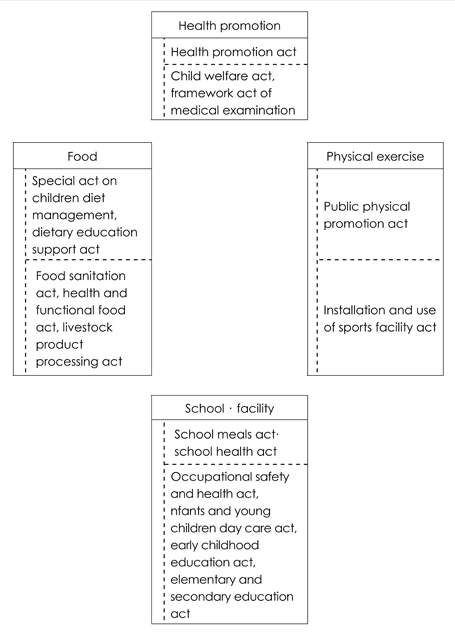Korean J Nutr.
2010 Aug;43(4):413-423. 10.4163/kjn.2010.43.4.413.
Current Status and Improvements of Obesity Related Legislation
- Affiliations
-
- 1Health Promotion Research Division, Korea Institute for Health and Social Affairs, Seoul 122-705, Korea. forsome@paran.com
- KMID: 2268030
- DOI: http://doi.org/10.4163/kjn.2010.43.4.413
Abstract
- Great attentions have been given to obesity in Korea, while the obesity rate has rapidly risen up due to various reasons including the dietary change into the western style. Central and local governments have tried to reduce the rate through various policies and action plans. The governments' activities are frequently criticised to be more coordinated in order to achieve the aim of the activities. The purpose of this study was to develop the coordination strategies through the examination of the acts relating to obesity. At present, activities relating to obesity are based on 25 acts including 'Health Promotion Act', 'Special Act on Children Diet Management' and so on. Six ministries including the Ministry of Health and Welfare and the Ministry of Education, Science and Technology are in charge of these acts. As a result, a number of areas, especially dietary guidance, research, manpower and institutions, seem to overlap. In a short term, Ministerial Council on Obesity should be established in order to enforce the coordination of the policies and activities. In the mid-long term, it is recommended that functions of the Ministries should be more simplified through the reorganization.
Keyword
Figure
Cited by 1 articles
-
Production and evaluation of children's dietary life safety index data on metropolitan cities and provinces in Korea
Young-Sun Choi, Jung-Sug Lee, Hye-Young Kim, Tong-Kyung Kwak, Hae Rang Chung, Sehyug Kwon, Youn-Ju Choi, Soon-Kyu Lee, Myung-Hee Kang
Nutr Res Pract. 2012;6(6):542-550. doi: 10.4162/nrp.2012.6.6.542.
Reference
-
1. Korean Ministry of Health and Welfare. Report on National Health and Nutrition Survey 1998. 1999. Seoul: Korean Ministry of Health and Welfare.2. Korean Ministry of Health and Welfare. Report on Korea National Health and Nutrition Examination Survey 2001. 2002. Seoul: Korean Ministry of Health and Welfare.3. Korean Ministry of Health and Welfare. Report on Korea National Health and Nutrition Examination Survey 2005. 2006. Seoul: Korean Ministry of Health and Welfare.4. Korean Ministry of Health and Welfare. Report on National Health Statistic 2007. 2009. Seoul: Korean Ministry of Health and Welfare.5. World Health Organization Regional Office for the Western Pacific (WPRO). the International Association for the Study of Obesity (IASO). the International Obesity Task Force (IOTF). The Asia-Pacific perspective-redefining obesity and its treatment. 2000.6. Lakka HM, Laaksonen DE, Lakka TA, Niskanen LK, Kumpusalo E, Tuomilehto J, Salonen JT. The metabolic syndrome and total and cardiovascular disease mortality in middle-aged men. JAMA. 2002. 288(21):2709–2716.
Article7. Ford ES. The metabolic syndrome and mortality from cardiovascular disease and all-causes: findings from the National Health and Nutrition Examination Survey II Mortality Study. Atherosclerosis. 2004. 173(2):309–314.
Article8. National Health Insurance cooperation notice 2008. 2008.9. Seo MK, Choi EJ, Shin YJ, Kim DJ, Song HJ. Evaluation of the National health promotion policies and its measures. 2006. KIHASA.10. Tak YJ, Lee YS, Lee JS, Kang JH. The T trend of Obesity-related Researches in Korea: from 1984 to 2002. Korean J Obes. 2004. 13(1):1–13.11. Act on School Physical Education Public hearing materials Act. http://mom.eduhope.net/bbs/view.php?board=mom_6_3&id=1242&page=5.
- Full Text Links
- Actions
-
Cited
- CITED
-
- Close
- Share
- Similar articles
-
- Medical ethics guidelines and related laws
- Current status and epidemiology of adult obesity in Korea
- Introducing a legal mandate for basic medical education accreditation in Korea
- Current Status and the Future of Occupational Safety and Health Legislation in Low- and Middle-Income Countries
- Current status of obesity treatment in Korea:based on the 2020 Korean Society for the Study of Obesity guidelines for obesity management


